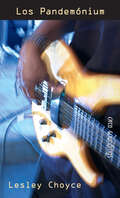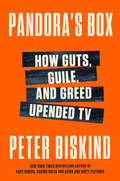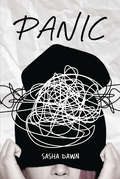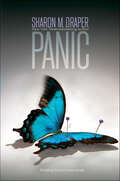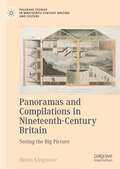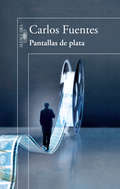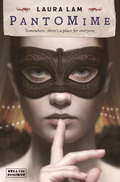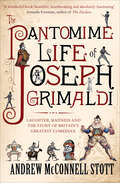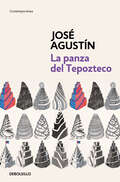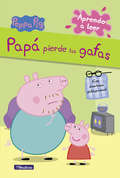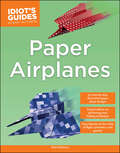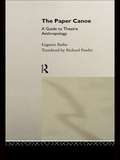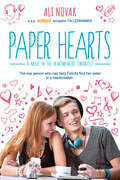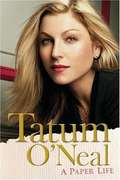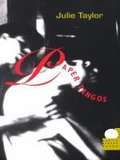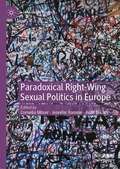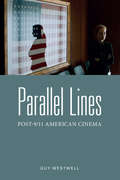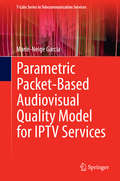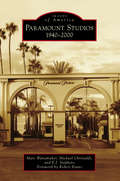- Table View
- List View
Pandemie im Film: Religiöse und ästhetische Transformationen in der Populärkultur (pop.religion: lebensstil – kultur – theologie)
by Inge Kirsner Harald Schroeter-WittkeUntersucht wird die theologische und ästhetische Bearbeitung der Pandemien in dystopischen und Science-Fiction-Filmen sowie Serien. Zwischen Verschwörungstheorien, der Sicht als Strafe Gottes und der fatalistischen Annahme eines "notwenigen Übels" changieren die Erklärungsmodelle im Film wie auch in der gesellschaftlichen Wirklichkeit. Filme bieten dabei stellvertretend narrative Lösungsmodelle an. Die Katastrophe wird auf diese Weise dem beängstigenden Alltag für kurze Zeit enthoben, was eine der Reflexion zuträgliche Distanz ermöglicht. Exemplarisch wird ein sich wandelndes Rollen-, Gesellschafts- und Gottesbild aufgezeigt, das zu religionspädagogischen Reflexionen anregt.
Los Pandemónium: (Thunderbowl) (Spanish Soundings)
by Lesley ChoyceThunderbowl, la banda de Jeremy, es excelente, y acaba de conseguir su primera gran oportunidad: una serie de tocadas en el bar local. El problema es que Jeremy debería estar al corriente con sus trabajos para la escuela, pero pasa casi todas las noches en el escandaloso club tratando de mantener a la banda unida. Equilibrar los sueños de éxito con la realidad de la industria de la música obligará a Jeremy a tomar decisiones muy difíciles. Jeremy's band, Thunderbowl, is hot, and they have had their first big break—a long-term gig at a local bar. The problem is that while Jeremy should be keeping up with his school work, he is spending most nights in a rowdy club, trying to keep the band together. Balancing dreams of success with the realities of the music business force Jeremy to make tough choices.
Pandora's Box: How Guts, Guile, and Greed Upended TV
by Peter BiskindBestselling author of Easy Riders, Raging Bulls and Down and Dirty Pictures, cultural critic Peter Biskind turns his eye toward the new golden age of television, sparked by the fall of play-it-safe network TV and the rise of boundary-busting cable, followed by streaming, which overturned both—based on exclusive, candid, and colorful interviews with executives, writers, showrunners, directors, and actorsWe are now lucky enough to be living through the era of so-called Peak TV, in which television, in its various guises and formats, has seized the entertainment mantle from movies and dominates our leisure time. How and why this happened is the subject of this book. Instead of focusing on one service, like HBO, Pandora’s Box asks, “What did HBO do, besides give us The Sopranos?” The answer: It gave us a revolution. Biskind bites off a big chunk of entertainment history, following HBO from its birth into maturity, moving on to the basic cablers like FX and AMC, and ending up with the streamers and their wars, pitting Netflix against Amazon Prime Video, Max, and the killer pluses—Disney, Apple TV, and Paramount. Since the creative and business sides of TV are thoroughly entwined, Biskind examines both, and the interplay between them. Through frank and shockingly intimate interviews with creators and executives, Pandora’s Box investigates the dynamic interplay of commerce and art through the lens the game-changing shows they aired—not only old warhorses like The Sopranos, but recent shows like The White Lotus, Succession, and Yellow- (both -stone and -jackets)—as windows into the byzantine practices of the players as they use money and guile to destroy their competitors. In the end, this book crystal-balls the future in light of the success and failures of the streamers that, after apparently clearing the board, now face life-threatening problems, some self-created, some not. With its long view and short takes—riveting snapshots of behind-the-scenes mischief—Pandora’s Box is the only book you’ll need to read to understand what’s on your small screen and how it got there.
Panic
by Sasha DawnA page-turning story about a teen's struggle to overcome her fears on her quest for truth, strength, and stardom. Madelaine loves music, loves the stage, and loves performing. When she finds a fragment of poetry that inspires her to finish a song she's been writing, she tracks down the poem's author online in hopes of starting a collaboration. But as more pieces of the poem find their way to her, she realizes the online poet can't possibly be the one who's leaving them for her. At the same time, some shocking family secrets upend Madelaine's home life. As Madelaine struggles to separate the images people present online from the realities of who they are, her quest for truth, strength, and stardom takes turns she never expected.
Panic
by Sharon M. DraperThis gripping, chillingly realistic novel from New York Times bestselling author Sharon Draper, “by turns pulse-pounding and inspiring” (Kirkus Reviews), shows that all it takes is one bad decision for a dream to become a nightmare.Diamond knows not to get into a car with a stranger.But what if the stranger is well-dressed and handsome? On his way to meet his wife and daughter? And casting a movie that very night—a movie in need of a star dancer? What then?Then Diamond might make the wrong decision.It’s a nightmare come true: Diamond Landers has been kidnapped. She was at the mall with a friend, alone for only a few brief minutes—and now she’s being held captive, forced to endure horrors beyond what she ever could have dreamed, while her family and friends experience their own torments and wait desperately for any bit of news.From New York Times bestselling author Sharon Draper, this is a riveting exploration of power: how quickly we can lose it—and how we can take it back.
Panoramas and Compilations in Nineteenth-Century Britain: Seeing the Big Picture (Palgrave Studies in Nineteenth-Century Writing and Culture)
by Helen KingstoneThis book shows how in nineteenth-century Britain, confronted with the newly industrialized and urbanized modern world, writers, artists, journalists and impresarios tried to gain an overview of contemporary history. They drew on two successive but competing conceptual models of overview: the panorama and the compilation. Both models claimed to offer a holistic picture of the present moment, but took very different approaches. This book shows that panoramas (360° views previously associated with the Romantic period) and compilations (big data projects previously associated with the Victorian fin de siècle) are intertwined, relevant across the entire century, and often remediated, making them crucial lenses through which to view a broad range of genre and forms. It brings together interdisciplinary research materials belonging to different period silos to create new understandings of how nineteenth-century audiences dealt with information overload. It argues for a new politics of distance: one that recognizes the value of immersing oneself in a situation, event or phenomenon, but which also does not chastise us for trying to see the big picture. This book is essential reading for students and scholars of nineteenth-century literature, history, visual culture and information studies.
Pantallas de plata
by Carlos FuentesThis is the story of a personal relationship with cinema. Carlos Fuentes tells about his earliest encounter with a movie theater while accompanied by his father, the dazzling moving images on the silver screen, and his subsequent and incurable love for cinema. The author had the opportunity to see movies in a good number of countries on both sides of the Atlantic, to know great directors and famous actors and actresses, to write screenplays, to see his own works translated to film, to be a judge in renowned festivals, and even to act. From all of this he derives a unique experience that he narrates here in absolutely confessional terms, and a good part of the time in first person. His preferences and likes, his obsessions, his interpretation of works, attitudes, tendencies, styles; all this and more is found here, written in a style more narrative than essay in tone. This work, just as it was written by the author, is a gift for readers, especially those who enjoy the greatest films of all time.
Pantomime
by Laura LamR.H. Ragona's Circus of Magic is the greatest circus of Ellada. Nestled among the glowing blue Penglass - remnants of a mysterious civilisation long gone - are wonders beyond the wildest imagination. It's a place where anything seems possible, where if you close your eyes you can believe that the magic and knowledge of the vanished Chimeras is still there. It's a place where anyone can hide.Iphigenia Laurus, or Gene, the daughter of a noble family, is uncomfortable in corsets and crinoline, and prefers climbing trees to debutante balls. Micah Grey, a runaway living on the streets, joins the circus as an aerialist's apprentice and soon becomes the circus's rising star. But Gene and Micah have balancing acts of their own to perform, and a secret in their blood that could unlock the mysteries of Ellada.
The Pantomime Life of Joseph Grimaldi: Laughter, Madness and the Story of Britain's Greatest Comedian
by Andrew McConnell StottThe son of a deranged Italian immigrant, Joseph Grimaldi (1778-1837) was the most celebrated of English clowns. The first to use white-face make-up and wear outrageous coloured clothes, he completely transformed the role of the Clown in the pantomime with a look as iconic as Chaplin's tramp or Tommy Cooper's magician. One of the first celebrity comedians, his friends included Lord Byron and the actor Edmund Kean, and his memoirs were edited by the young Charles Dickens. But underneath the stage paint, Grimaldi struggled with depression and his life was blighted with tragedy. His first wife died in childbirth and his son would go on to drink himself to death. In later life, the extreme physicality of his performances left him disabled and in constant pain. The outward joy and tomfoolery of his performances masked a dark and depressing personal life, and instituted the modern figure of the glum, brooding comedian. Drawing on a wealth of source material, Stott has written the definitive biography of Grimaldi and a highly nuanced portrait of Georgian theatre in London, from the frequent riots at Drury Lane to the spectacular excess of its arch-rival Sadler's Wells; from stage elephants running amok to recreations of Admiral Nelson's sea battles on flooded stages at the height of the Napoleonic Wars. Joseph Grimaldi left an indelible mark on British theatre and the performing arts, but his legacy is one of human struggle, battling demons and giving it his all in the face of adversity.
La panza del Tepozteco
by José Agustín RamírezJosé Agustín narra las peripecias de los niños con una enorme soltura impactante: su capacidad para expresar el mundo de los adolescentes, un mundo casi infantil, entrelazándolo por momentos con el mundo antiguo, es sorprendente. La narrativa de José Agustín posee un registro variado, que se expresa con buena fortuna y en formas diversas. Prueba de esto es La panza del Tepozteco, novela dirigida a lectores jóvenes que, sin embargo, el público adulto disfruta gozosamente. Bajo la piel de una novela de aventuras, La panza del Tepozteco indaga en torno a la pervivencia de los mitos prehispánicos mediante la mirada de seis niños citadinos #Tor, Homero, Érika, Alain, Selene y Yanira#. Los personajes descubren que los dioses antiguos del panteón azteca se han refugiado en el corazón de la montaña. La presencia de los pequeños, su entrada en el santuario, desatará una lucha entre deidades: algunas, como Tona, buscarán protegerlos, mientras que otras intentarán sacrificarlos, dejando atrás las enseñanzas de Quetzalcóatl.
Papa John: The Autobiography Of John Phillips
by John Phillips Jim JeromeSex, drugs, and rock 'n ' roll. It was the anthem of the sixties. The psychedelic code by which many lived --and died. And John Phillips, legendary founder and songwriter of the Mamas and the Papas, experienced it all. Now Phillips takes us on a dizzying roller-coaster ride from stardom in L.A. to drug busts in the Big Apple. In an intimate, gritty, all- too-true self-portrait, he offers a startling, reflective look at the turbulent sixties and beyond.
Papá pierde las gafas (Peppa Pig. Pictogramas)
by Varios AutoresEn esta divertida historia te contamos lo que pasó cuando Papá Pig perdió sus gafas. ¡Descubre cómo logramos encontrarlas! Papá Pig está leyendo el periódico y no encuentra sus gafas. Peppa y George se ofrecen para ayudarle a buscarlas. Descubre dónde encuentra Peppa las gafas. ¡Para que los más peques se diviertan leyendo esta historia con pictogramas y aprendiendo el vocabulario!
Paper Airplanes (Idiot's Guides)
by Nick RobinsonRelated to origami, paper airplanes originated from China and are toys devised entirely out of paper and adhesives (sometimes glue or tape) that utilize an aerodynamic shape to lift and soar. Idiot's Guides: Paper Airplanes features 20 of the coolest designs-- and offers easy-to-understand, step-by-step instructions. This book includes:- Step-by-step easy-to-understand illustrated folding instructions, including the level of cutting/folding difficulty, flight pattern, and durability levels to the corresponding airplanes. - 20 symmetric models, ranging in difficulty levels, which are illustrated within the colorful guide.- 80 sheets of eye-catching, pre-designed printed 8.5x11 paper for readers to practice with and create planes.- Cool backgrounds that highlight each of the airplane projects.
The Paper Canoe: A Guide to Theatre Anthropology
by Eugenio BarbaFirst published in 1994. Routledge is an imprint of Taylor & Francis, an informa company.
Paper Hearts
by Ali Novak"I'm sorry," he said, slowly untying the ribbon that held his mask in place. "It's just-I didn't want you to think of me any differently." Somehow I kept my mouth from falling open. I knew his face, but my mind couldn't accept that he was the person looking down at me. "My real name is Alec."Felicity has her entire future planned. Ever since her older sister ran away, she's had the full weight of her mother's expectations on her shoulders. So she works hard to get straight As and save for college. Except sometimes the best things in life are unplanned-like when Felicity meets a handsome, masked stranger while she is volunteering at a charity masquerade ball. She never thought he'd flirt with her. And she certainly never thought he'd turn out to be a member of the world-famous Heartbreakers band, Alec. Then Felicity uncovers a shocking family secret. Suddenly, she, Alec, and her two best friends are off on a road trip to find Felicity's missing sister. And she's about to discover that unexpected turns have a peculiar way of landing her right where she needs to be...
A Paper Life
by Tatum O'NealThe sensational memoir by one of Hollywood's most talented and turbulent leading ladies--filled with stunning revelations--is an inspirational true tale of survival and triumph against all odds.
A Paper Life
by Tatum O'NealThe sensational memoir by one of Hollywood's most talented and turbulent leading ladies--filled with stunning revelations--is an inspirational true tale of survival and triumph against all odds.
Paper Tangos
by Julie TaylorTango. A multidimensional expression of Argentine identity, one that speaks to that nation's sense of disorientation, loss, and terror. Yet the tango mesmerizes dancers and audiences alike throughout the world. In Paper Tangos, Julie Taylor--a classically trained dancer and anthropologist--examines the poetics of the tango while describing her own quest to dance this most dramatic of paired dances.Taylor, born in the United States, has lived much of her adult life in Latin America. She has spent years studying the tango in Buenos Aires, dancing during and after the terror of military dictatorships. This book is at once an account of a life lived crossing the borders of two distinct and complex cultures and an exploration of the conflicting meanings of tango for women who love the poetry of its movement yet feel uneasy with the roles it bestows on the male and female dancers. Drawing parallels among the violences of the Argentine Junta, the play with power inherent in tango dancing, and her own experiences with violence both inside and outside the intriguing tango culture, Taylor weaves the line between engaging memoir and insightful cultural critique. Within the contexts of tango's creative birth and contemporary presentations, this book welcomes us directly into the tango subculture and reveals the ways that personal, political, and historical violence operate in our lives.The book's experimental design includes photographs on every page, which form a flip-book sequence of a tango. Not simply a book for tango dancers and fans, Paper Tangos will reward students of Latin American studies, cultural studies, anthropology, feminist studies, dance studies, and the art of critical memoir.
Parade
by Donald CrewsShowing the same dynamic energy and brilliant colors as in <i>Freight Train</i> and <i>Truck</i>, Donald Crews conveys the breathless anticipation and delighted enjoyment generated by a parade in this book.
Paradoxical Right-Wing Sexual Politics in Europe (Global Queer Politics)
by Cornelia Möser Jennifer Ramme Judit TakácsHow did far-right, hateful and anti-democratic ideologies become so successful in many societies in Europe? This volume analyses the paradoxical roles sexual politics have played in this process and reveals that the incoherence and untruthfulness in right-wing populist, ultraconservative and far-right rhetorics of fear are not necessarily signs of weakness. Instead, the authors show how the far right can profit from its own incoherence by generating fear and creating discourses of crisis for which they are ready to offer simple solutions. In studies on Poland, Hungary, Spain, Italy, Austria, Ireland, Northern Ireland, Portugal, France, Sweden and Russia, the ways far-right ideologies travel and take root are analysed from a multi-disciplinary perspective, including feminist and LGBTQI reactions. Understanding how hateful and antidemocratic ideologies enter the very centre of European societies is a necessary premise for developing successful counterstrategies.
Parallel Lines: Post-9/11 American Cinema
by Guy WestwellParallel Lines describes how post-9/11 cinema, from Spike Lee's 25th Hour (2002) to Kathryn Bigelow's Zero Dark Thirty (2012), relates to different, and competing, versions of US national identity in the aftermath of the September 11 terrorist attacks. The book combines readings of individual films (World Trade Center, United 93, Fahrenheit 9/11, Loose Change) and cycles of films (depicting revenge, conspiracy, torture and war) with extended commentary on recurring themes, including the relationship between the US and the rest of the world, narratives of therapeutic recovery, questions of ethical obligation.The volume argues that post-9/11 cinema is varied and dynamic, registering shock and upheaval in the immediate aftermath of the attacks, displaying capacity for critique following the Abu Ghraib prisoner abuse scandal mid-decade, and seeking to reestablish consensus during Obama's troubled second term of office.
Parallel Lines: Post-9/11 American Cinema
by Guy WestwellDescribes how post-9/11 cinema, from Spike Lee's 25th Hour (2002) to Kathryn Bigelow's Zero Dark Thirty (2012), relates to different, and competing, versions of US national identity in the aftermath of the September 11th terrorist attacks
Parallel Lines
by Guy WestwellParallel Lines describes how post-9/11 cinema, from Spike Lee's 25th Hour (2002) to Kathryn Bigelow's Zero Dark Thirty (2012), relates to different, and competing, versions of US national identity in the aftermath of the September 11th terrorist attacks. The book combines readings of individual films (World Trade Center, United 93, Fahrenheit 9/11, Loose Change) and cycles of films (depicting revenge, conspiracy, torture and war) with extended commentary on recurring themes, including the relationship between the US and the rest of the world, narratives of therapeutic recovery, questions of ethical obligation.The volume argues that post-9/11 cinema is varied and dynamic, registering shock and upheaval in the immediate aftermath of the attacks, displaying capacity for critique following the Abu Ghraib prisoner abuse scandal mid-decade, and seeking to reestablish consensus during Obama's troubled second term of office.
Parametric Packet-based Audiovisual Quality Model for IPTV services
by Marie-Neige GarciaThis volume presents a parametric, packet-based, comprehensive model to measure and predict the audiovisual quality of Internet Protocol Television services as it is likely to be perceived by the user. The comprehensive model is divided into three sub-models referred to as the audio model, the video model, and the audiovisual model. The audio and video models take as input a parametric description of the audiovisual processing path, and deliver distinct estimates for both the audio and video quality. These distinct estimates are eventually used as input data for the audiovisual model. This model provides an overall estimate of the perceived audiovisual quality in total. The parametric description can be used as diagnostic information. The quality estimates and diagnostic information can be practically applied to enhance network deployment and operations. Two applications come to mind in particular: Network planning and network service quality monitoring. The audio model can be used indifferently for both applications. However, two variants of the video model have been developed in order to address particular needs of the applications mentioned above. The comprehensive model covers effects due to resolution, coding, and IP-packet loss in case of RTP-type transport. The model applied to quality monitoring is standardized under the ITU-T Recommendations P. 1201 and P. 1201. 2.
Paramount Studios: 1940-2000 (Images of America)
by Robert Evans Marc Wanamaker E. J. Stephens Michael ChristaldiThe fascinating tale of Hollywood powerhouse Paramount Pictures--beginning with its birth in the 1910s through the turbulent decade of the 1930s--was told in Early Paramount Studios by Marc Wanamaker, Michael Christaldi, and E.J. Stephens. Now the same authors are back to tell the next 60 years of the studio saga in Paramount Studios: 1940-2000, with a foreword by former Paramount head of production Robert Evans. This book picks up the story during the time of World War II--a successful era for the studio--which was followed by a decade of decline due to the upstart medium of television. By the 1960s, the studio teetered on the brink of bankruptcy before rebounding, thanks to several 1970s blockbusters, such as Love Story, The Godfather, and Chinatown. The tale continues through the final decades of the 20th century when Paramount showcased some of the greatest hits in its history.

